One look at Cavan Biggio’s stat line would probably leave most unimpressed. He got off to a hot start when he was first called up and had a .811 OPS and a 116 wRC+ through the end of June. Since then, it’s been less fun, with a .631 OPS and a 75 wRC+. For the season, he has a .733 OPS with a wRC+ of just 99. This is just his first taste of life as a major leaguer though, and while it’s more common to see prospects come up and dominate right away a la Yordan Alvarez, Pete Alonso and his Blue Jays teammate Bo Bichette, it’s still okay for a rookie to get off to a slow start.
While Biggio was never a top prospect, he got a lot of love in prospect circles after a strong 2018 season in AA. He continued his strong play in AAA with a 152 wRC+ in 43 games. He’s been just okay since his call-up but hidden underneath the mediocre slash line, there is a lot to like. For instance, his 16.8% walk rate is a mark that is only beaten by six other hitters with more than 300 plate appearances. Walking a lot is nice, but that alone is not enough. There are a lot of great hitters towards the top of that leaderboard, towards the top, but there are also a handful of mediocre hitters such as Brandon Belt, Matt Carpenter, Brian Dozier and Logan Forsythe.
Unlike those hitters, there are actually other things that get me excited about Biggio. Speed is one of them, as Statcast places him in the 82nd percentile, but beyond that I believe there is more within Biggio’s profile—mostly in his batted-ball profile and plate discipline—that will put him in a position for future success.
While the results haven’t been there quite yet for Biggio, he is doing some things very well and can already be thrown into an exclusive group of some of the better hitters in the game. I’m not saying that Biggio is as good or will be as good as these hitters, but I do believe that Biggio is setting the foundation to have success in this league. No matter how you look at it, Biggio is a unique player and he could be a special player in the not-too-distant future.
Addressing the Elephant in the Room
The one thing I didn’t mention during the introduction was Biggio’s high strikeout rate. At 28.3%, the rate is definitely high, and higher than you would want for a player who is only slugging .362. There are only three other hitters in baseball who strike out nearly 30% of the time or higher while also slugging less than .400: Chris Davis, Wil Myers and Steve Wilkerson. They aren’t exactly hitters you necessarily want to be compared to and this is not exactly a good start for a player I’m trying to hype up, but I don’t think this is actually bad news. Yes, the slugging is still too low but I think that will get better, as I’ll explain later on. But for now, let’s keep in mind that none of the players with the highest strikeout rates in the game walk as much as Biggio does. A hitter can have success with a high strikeout rate when they also have a high walk rate. Here’s a table showing the hitters with a similar strikeout and walk rate to Biggio:
| Name | BB% | K% | wOBA | wRC+ |
|---|---|---|---|---|
| Max Muncy | 15.4 | 24.9 | 0.376 | 136 |
| Bryce Harper | 15.1 | 26.5 | 0.361 | 122 |
| Daniel Vogelbach | 16.1 | 25.6 | 0.344 | 119 |
| Cavan Biggio | 16.1 | 28.7 | 0.307 | 90 |
Biggio is the one that stands out here, as he is the only hitter in this group that has a wRC+ less than 100, but this is a group of good hitters. A hitter can have success with walk and strikeout rates like this. But I do think that Biggio’s strikeout rate can and will improve. I also think his strikeout rate may need some more explanation. We know that he is a very disciplined hitter, but that excellent plate discipline may be part of what is causing the high strikeout rate. Take a look at his plate discipline rates:
| O-Swing% | Z-Swing% | Swing% | O-Contact% | Z-Contact% | Contact% | SwStr% |
|---|---|---|---|---|---|---|
| 14.4 % | 63.4 % | 35.1 % | 45.9 % | 86.8 % | 77.1 % | 8.0 % |
This doesn’t look like the profile of a free-swinging, hack-at-everything hitter that you would expect to have such a high strikeout rate. When you look at some notable plate discipline metrics of all hitters compared to their strikeout rates, you really see how much Biggio stands out. Take a look at this first graph comparing swing rate to strikeout rate:
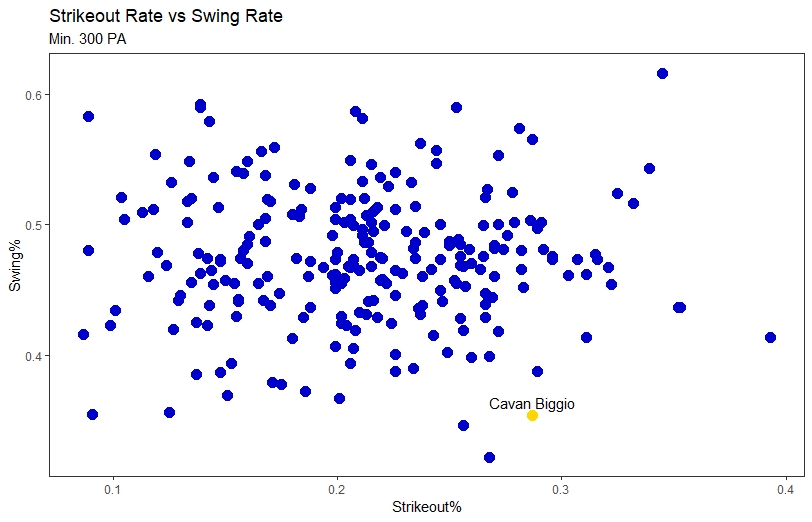
Despite swinging at one of the lowest rates among hitters, Biggio is striking out at one of the highest rates among hitters. This leads me to believe his strikeout rate is a function of his plate discipline. His chase rate or O-Swing% also supports this. We know that Biggio doesn’t chase pitches out of the zone very often, and when we look at O-Swing rate compared to strikeout rate, we see thathe is an outlier in this area as well, as evidenced by this graph:
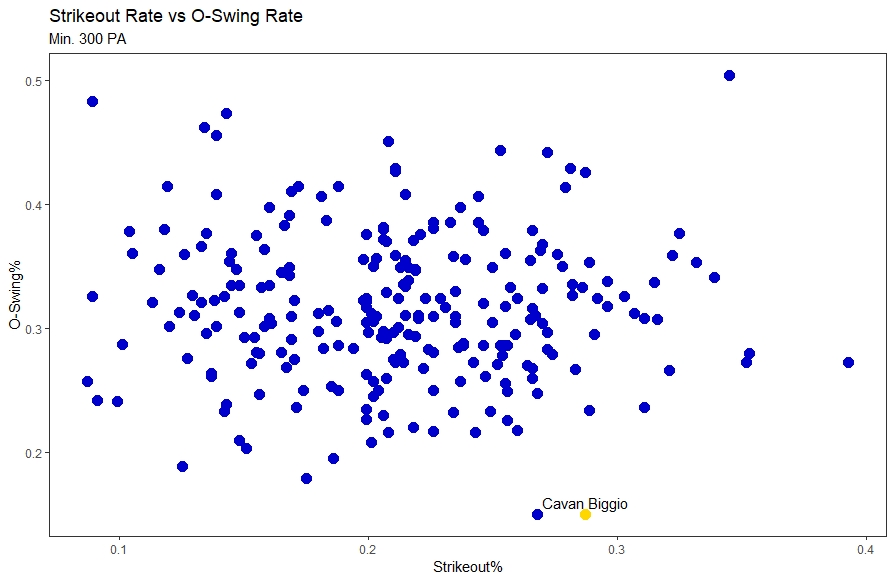
The player directly to the left of Biggio is Logan Forsythe, and without Forsythe being there, Biggio would be in entirely his own area of the graph. showing how extreme he is. So we can rule out that chasing isn’t what is causing the high strikeout rate, but how about swinging and missing? Maybe when he is actually swinging, he’s whiffing too much? That isn’t the case either, and I have another graph to prove it:
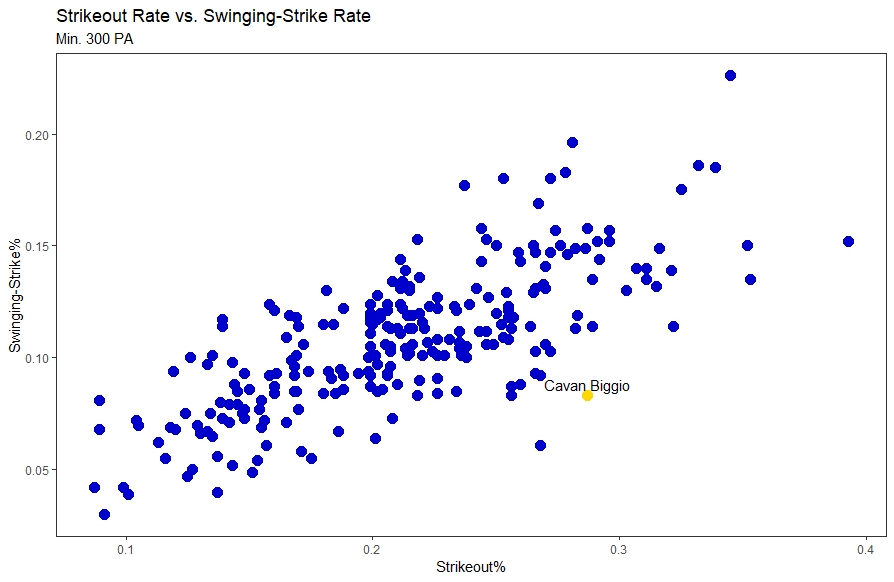
While Biggio is closer to the pack in this graph than he is in the other two graphs, he still stands out as unique here. It is unusual and unexpected to see a hitter strikeout as much as Biggio has while whiffing at a pretty low rate. This leads me to believe even more that Biggio’s high strikeout rate has more to do with his patience and plate discipline instead of chasing bad pitches and swinging and missing.
To try and put it all together, I figured out the percentage of every player’s strikeout rates looking against their rates swinging and then created a scatterplot to see if Biggio is something of an outlier here as well. Here are the results:
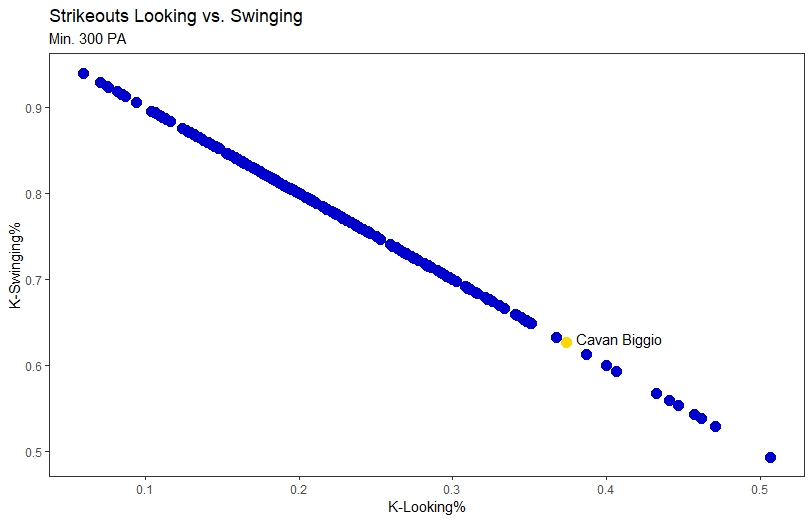
Once again, Biggio looks like an outlier here, with only a handful of other players with a greater percentage of their strikeouts being of the looking variety. Biggio’s K-Looking rate of 37.4% is the 11th highest among hitters with at least 300 plate appearances, and well above the league average of 21.9%. This could be perhaps easily remedied by being more aggressive on pitches inside the strike zone and pitches he feels like he should be able to do damage with. If you’re interested in seeing more data about this, here is a leaderboard I made on the subject that I plan to update. Overall, this high rate of called strike threes is surely a better sign and better for his future than it would be if he was hacking at everything and whiffing instead.
Knowing that, we can breathe a sigh of relief that a lot of worries about his high strikeout rate can be explained away. I mentioned Biggio’s strong plate discipline, but now let’s take a closer look at the other aspects of his plate discipline. Looking at hitters with similar discipline metrics to Biggio, it’s again a pretty select group of hitters. See for yourself:
| Name | wOBA | O-Swing% | Z-Swing% | Swing% | SwStr% | BB% |
|---|---|---|---|---|---|---|
| Alex Bregman | 0.404 | 18.9% | 59.8% | 35.6% | 4.7% | 16.6% |
| Tommy Pham | 0.354 | 19.5% | 60.8% | 37.2% | 6.7% | 13.2% |
| Robbie Grossman | 0.313 | 17.9% | 63.4% | 37.8% | 5.5% | 12.9% |
| Cavan Biggio | 0.307 | 15.0% | 62.9% | 35.4% | 8.3% | 16.8% |
| Logan Forsythe | 0.301 | 15.0% | 53.3% | 32.2% | 6.0% | 12.1% |
While not a list of some of the best hitters in the game, these are some of the most patient hitters in the game. Alex Bregman and Tommy Pham have had strong seasons with Bregman likely to receive some MVP votes. Out of these comparable hitters, Biggio has the highest walk rate with 16.8% that slightly edges Bregman at 16.6%. For a rookie with less than 100 games of experience, it’s kind of crazy to see him leading the pack in terms of plate discipline. But there is a lot Biggio still needs to do to put himself in the same conversation as Bregman or Pham. What makes hitters like Bregman and Pham stand out is that they have more to their games than just patience. Bregman is having his strongest season yet and is one of the most complete hitters in the game and Pham is following up his strong 2018 season with a season that looks a lot like it. Biggio needs to do damage on pitches he actually does decide to swing at to get strong overall results.
Batted Ball
Now that we’ve addressed the odd strikeout rate, let’s move on to his batted-ball profile. So far during his first season, Biggio’s profile stands out with not only one of the highest line drive rates but also one of the lowest ground-ball rates. Those two factors usually lead to a high fly-ball rate, which is true with Biggio’s 44.3% placing him inside the top-25 in baseball. While a high fly-ball rate could lead to a lower BABIP, hitters that have similar batted ball types as Biggio are some hitters who have had pretty strong seasons thus far:
| Name | LD% | GB% | FB% | wOBA | wRC+ |
|---|---|---|---|---|---|
| Mike Trout | 27.3 | 24.6 | 48.1 | 0.437 | 181 |
| Cody Bellinger | 27.1 | 30.1 | 42.8 | 0.422 | 166 |
| Brandon Lowe | 25.9 | 31.0 | 43.1 | 0.431 | 127 |
| Jorge Polanco | 25.3 | 29.0 | 45.7 | 0.355 | 120 |
| Kyle Seager | 26.0 | 29.6 | 44.4 | 0.343 | 119 |
| Cavan Biggio | 27.0 | 28.7 | 44.3 | 0.307 | 90 |
This is a pretty solid group of hitters that features two MVP frontrunners in Mike Trout and Cody Bellinger. Now there is a catch here—while he has laid the foundation this season, he hasn’t quite put it all together. Those batted balls from Biggio haven’t had the results that the other hitters in this group have had. His slugging on fly balls and line drives are in the bottom half of the leaderboard and although his .767 slugging on line drives does trail his .875 expected mark, we need to keep in mind that the quality of contact needs to get better for Biggio to reach his full potential. But, this is a good mix of line drives and ground balls that puts him in good company. Where he really stands out among these hitters is where those batted balls end up going. Looking at the same group of hitters as in the table above, Biggio stands out in his own way:
| Name | Pull% | Cent% | Oppo% |
|---|---|---|---|
| Mike Trout | 42.7 | 33.0 | 24.3 |
| Cody Bellinger | 49.4 | 31.3 | 19.4 |
| Brandon Lowe | 44.9 | 34.7 | 20.5 |
| Jorge Polanco | 36.5 | 37.4 | 26.1 |
| Kyle Seager | 42.3 | 32.5 | 25.2 |
| Cavan Biggio | 51.1 | 30.8 | 18.1 |
Cody Bellinger is the only hitter in this group with a comparable pull percentage and none of these hitters pull the ball as much as Biggio does. Actually, Biggio and Bellinger have a lot of similarities when it comes to their batted ball metrics. Let’s put it all together for a closer look:
| Name | wOBA | BB% | K% | LD% | GB% | FB% | Pull% | Cent% | Oppo% |
|---|---|---|---|---|---|---|---|---|---|
| Cody Bellinger | 0.422 | 14.00% | 16.70% | 27.10% | 30.10% | 42.80% | 49.10% | 31.70% | 19.30% |
| Cavan Biggio | 0.307 | 16.10% | 28.70% | 27.00% | 28.70% | 44.30% | 50.60% | 31.00% | 18.40% |
They look eerily similar to each other. Now, I am in no way suggesting that Biggio is the next Bellinger. For starters, Bellinger’s wOBA is over 100 points higher and his strikeout rate is over ten points lower. What I am suggesting is that if Biggio can make improvements to his quality of contact, he could get strong results because when Biggio puts the ball in play, he does so in a way that compares extremely well to one of the best hitters in the game today. That’s easier said than done obviously, but this is definitely a profile that can and should work in the future.
That’s the thing though. Depending on the period of time you look at, Biggio has been anywhere between one of the best in getting hard contact or one of the worst. When he first got called up on May 24 through the end of June, Biggio was hitting the life out of the ball, with a 56.1% hard-hit rate that ranked fourth-best in baseball in that time span. When he started to struggle in July, that hard-hit began to plummet and he finished with a 38.2% hard-hit rate in July, one of the lowest in the month. Since then, it’s just a 31.2% hard-hit rate, but that number isn’t coming with weak contact, with just 18.0% soft contact in that time span with a high 50.8% medium contact rate. What we ultimately get is a hitter that looks like this:
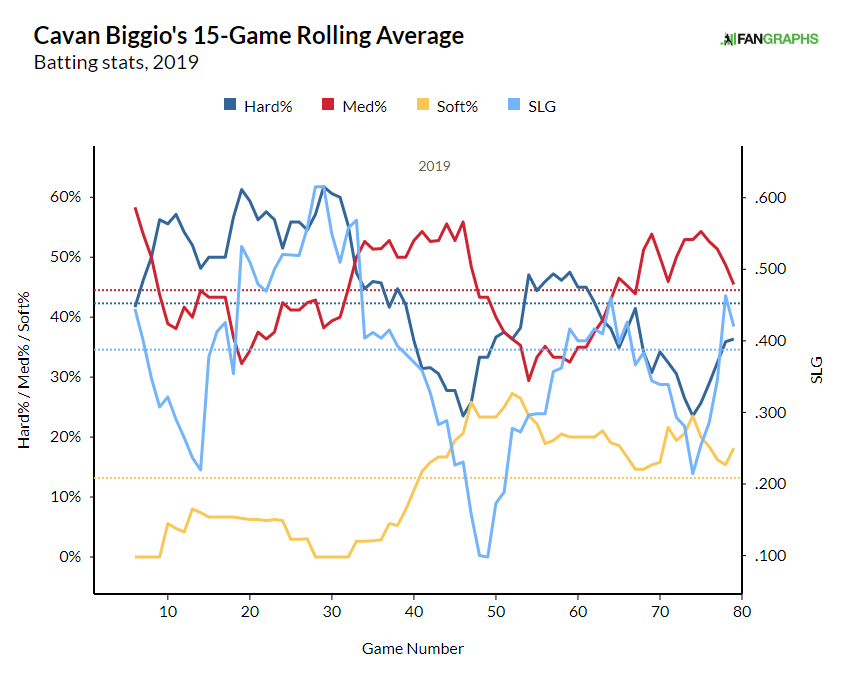
It’s typical that a hitter’s slugging is tied to how hard they hit the ball, and Biggio looks to be no different. There is a lot of fluctuation here, and I don’t think we know what type of hitter Biggio is when it comes to quality of contact at this level yet, but we’ve seen what type of hitter he can be when he consistently makes hard contact. The next step is to make adjustments to do more with pitches he can do more with. With plate discipline that is among the best in the game, Biggio needs to capitalize on the strikes that pitchers will be forced to throw him.
Conclusion
Through just 79 Major League games, Cavan Biggio has experienced both the highs and lows of playing Major League Baseball. With a 116 wRC+ through the end of June, he already showcased his strong plate discipline as he emerged as one of the most patient hitters in the game from the get-go. However, as the results started to get worse, Biggio still did a lot of things to like that could set him up to be one of the more productive hitters in the game.
It’s hard to develop into one of the best players in baseball, but it’s hard to argue with how encouraging his profile looks. Despite not getting the best results, Biggio has done a lot of things well and the next step is to make necessary adjustments. It’s cliche to say that baseball is a game of adjustments, but it is so true. The players who are able to make meaningful adjustments are the ones that stick around for a long time. Making adjustments is easier said than done, but if Biggio is able to do more with the mistakes pitchers give him by making better contact when he puts the ball in play, combined with his strong foundation featuring top of the line plate discipline, and a good mix of batted ball types plus elite speed, there is a lot to like from Biggio that could make him relevant for the right reasons before too long.
Featured Image by Gerry Angus/Icon Sportswire.

